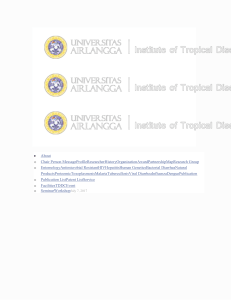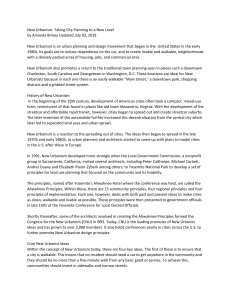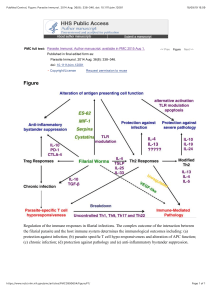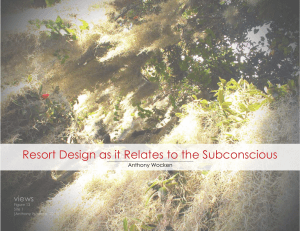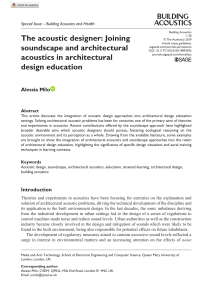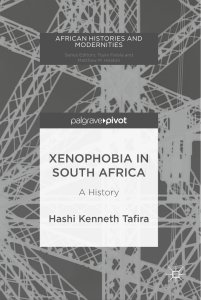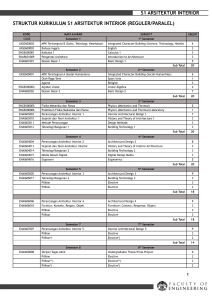Uploaded by
common.user34044
The Networks of Tropical Architecture: History and Context
advertisement
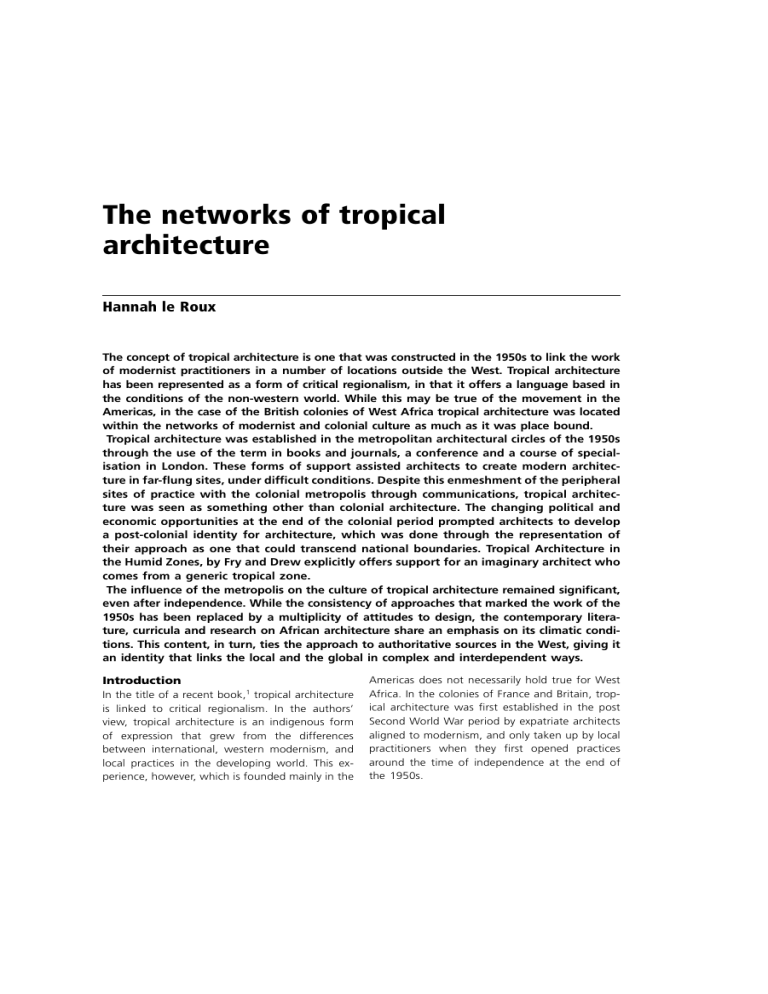
The networks of tropical architecture 1111 2 3111 4 5 6 7 8 9 10111 1 2 3 4 5 6 7 8 9 20111 1 2 3 4 5 6 7 8 9 30111 1 2 3 4 5111 1111 Hannah le Roux The concept of tropical architecture is one that was constructed in the 1950s to link the work of modernist practitioners in a number of locations outside the West. Tropical architecture has been represented as a form of critical regionalism, in that it offers a language based in the conditions of the non-western world. While this may be true of the movement in the Americas, in the case of the British colonies of West Africa tropical architecture was located within the networks of modernist and colonial culture as much as it was place bound. Tropical architecture was established in the metropolitan architectural circles of the 1950s through the use of the term in books and journals, a conference and a course of specialisation in London. These forms of support assisted architects to create modern architecture in far-flung sites, under difficult conditions. Despite this enmeshment of the peripheral sites of practice with the colonial metropolis through communications, tropical architecture was seen as something other than colonial architecture. The changing political and economic opportunities at the end of the colonial period prompted architects to develop a post-colonial identity for architecture, which was done through the representation of their approach as one that could transcend national boundaries. Tropical Architecture in the Humid Zones, by Fry and Drew explicitly offers support for an imaginary architect who comes from a generic tropical zone. The influence of the metropolis on the culture of tropical architecture remained significant, even after independence. While the consistency of approaches that marked the work of the 1950s has been replaced by a multiplicity of attitudes to design, the contemporary literature, curricula and research on African architecture share an emphasis on its climatic conditions. This content, in turn, ties the approach to authoritative sources in the West, giving it an identity that links the local and the global in complex and interdependent ways. Introduction In the title of a recent book,1 tropical architecture is linked to critical regionalism. In the authors’ view, tropical architecture is an indigenous form of expression that grew from the differences between international, western modernism, and local practices in the developing world. This experience, however, which is founded mainly in the Americas does not necessarily hold true for West Africa. In the colonies of France and Britain, tropical architecture was first established in the post Second World War period by expatriate architects aligned to modernism, and only taken up by local practitioners when they first opened practices around the time of independence at the end of the 1950s. 380 The networks of tropical architecture In Britain’s West African colonies of Nigeria and the Gold Coast, now Ghana, architectural practices Fry and Drew, the Architects Co-Partnership, James Cubitt and Associates and Godwin and Hopwood designed the infrastructure of the colonial system. The scope of work (figs 1–4) included town and village planning, a considerable number of educational buildings, houses for expatriates, commercial buildings and government offices. The work of these practices between the late 1940s and the early 1960s shows a remarkably cohesive attitude towards design, specifically in their response to climatic conditions. This coherence is all the more remarkable given the distances between Britain and the sites of practice in Africa and elsewhere. Rather than being a form of place-bound resistance, tropical architecture in West Africa seems to have grown out of conditions of displacement and compensatory linkages. The story of this period reflects the influence of the networks of architecture, as much as of its products, on a group of architects and its succeeding generations. In particular, the relationFigure 1. Fry, Drew and Partners University of Ibadan, Nigeria 1947–1951. Dormitory blocks in 2002 (photograph by Hannah le Roux). ship between a centre of knowledge in London and Britain’s colonial territories in the tropics spread and framed the production of tropical architecture. In this respect, the influence of metropolitan culture remains apparent in modern West African architecture, even after independence. What does this say about the identity of a form of regionalism such as tropical architecture? An architecture for all seasons The spread of modern architecture to the countries outside the West in the 1950s can be associated with developments in climatic design and communications. New forms of climatic design, building on the work of prewar architects who had extended the early, European phase of modernism into approaches that would suit sites elsewhere, were promoted through the media, education and technical support to architects in the tropics. This publicity established the concept of ‘tropical architecture’ as an orthodoxy for practices abroad by the early 1950s. A common attitude to design, in which architects drew off each others’ experiences and had access to technical information, runs through the body of built work of the decade in the former colonies of West Africa. Prior to the 1950s, several architects had experimented with alternatives or additions to the sheer and well-glazed façades of modernism that, although useful in the winters of Western Europe, performed as greenhouses in warmer conditions. A Greek architect, Stamo Papadaki, had experimented with the use of sun breakers and deep overhangs to control sun penetration prior to 1921.2 In the 1929 design for her seaside house, E1027, Eileen 1111 2 3 4 5 6 7 8 9 10111 1 2 3 4 5 6 7 8 9 20111 1 2 3 4 5 6 7 8 9 30111 1 2 3 4 5111 Hannah le Roux 1111 2 3 4 5 6 7 8 9 10111 1 2 3 4 5 6 7 8 9 20111 1 2 3 4 5 6 7 8 9 30111 1 2 3 4 5111 381 Figure 2. Architects’ CoPartnership Ansar-ur-Deen School, Lagos, Nigeria, 1957 (photograph by Architects’ Co-Partnership). Gray used a variety of shading devices, including adjustable, sliding louvres and canvas awnings to allow variable control of the sun. In the 1930s, Brazilian architects began to effect sun control through the design of building façades with a strong formal effect. Between 1936 and 1943, Lucio Costa and colleagues, with le Corbusier as a consultant, designed a new office building for the Ministry of Education. The design used sets of adjust- able horizontal louvres, set into a three-dimensional gridded façade made from reinforced concrete, to allow ventilation and the entrance of solar radiation to be controlled from inside the building.3 The aesthetic effect of the tall building with its everchanging contrasts of light and shade was startling and innovative. Le Corbusier claimed credit for the idea, somewhat belatedly, in a section on the Brise Soleil in the 1946 edition of his Complete Works.4 382 The networks of tropical architecture Figure 3. Cubitt Scott and Partners College of Technology, Kumasi, 1951 (photograph by James Cubitt Associates). The Brazilian application of the brise soleil gave a solution that would allow the use of glazed façades in hot climates.5 It is not surprising that le Corbusier’s development of the brise soleil follows the expansion of his career into the hot climates of Tunisia, Algeria, Brazil, and India between the 1930s and 50s. Le Corbusier’s leading role in the avant-garde modern movement gave his use of the brise-soleil an authoritative stamp, and claimed it from the Brazilians for an international application, fulfilling his vision of an ‘international’ architecture. Le Corbusier’s experimentation with climate recalls other modernist research into solar ingress in housing. Walter Gropius and Hannes Meyer had used sun diagrams in the 1920s in order to create rational standards for building spacing. Their concern was with allowing sufficient sunlight to enter buildings, in contrast to the dark conditions in which many people lived in European cities. Although the post-war modernists were concerned with reducing heat and glare, these precedents were influential in establishing climatic thinking in the design of buildings. The use of diagrams as an explanatory tool was another technique that was to prove influential. Almost simultaneously with the publication of le Corbusier’s account of the brise-soleil, the American avant-garde was establishing its own vocabulary of practices for hot climates. Frank Lloyd Wright’s interest in the climatic aspects of architecture had played out in the use of elements such as water, thick walls, deep overhangs and ventilation. Although Wright did not design in a hot and humid climate, his former student and collaborator, Antonin Raymond, was the co-designer of an influential tropical house for Guam around 19466 that served as a prototype for official American housing abroad, and is echoed in the design of the American embassy in Ghana. Events around the Second World War created a diaspora of modern architects from Germany and spread the rationale of modernism to new sites including those of the tropical southern parts of the United States. Walter Gropius was appointed as head of the Harvard Graduate School of Design in 1937. Amongst his early graduates was Paul Rudolph, whose designs for houses in Florida in the 1940s develop the use of shading devices and 1111 2 3 4 5 6 7 8 9 10111 1 2 3 4 5 6 7 8 9 20111 1 2 3 4 5 6 7 8 9 30111 1 2 3 4 5111 Hannah le Roux 1111 2 3 4 5 6 7 8 9 10111 1 2 3 4 5 6 7 8 9 20111 1 2 3 4 5 6 7 8 9 30111 1 2 3 4 5111 383 Figure 4. Godwin and Hopwood Boyle Street Residence, Lagos, Nigeria, 1956 (photograph by John Godwin and Gillian Hopwood). 384 The networks of tropical architecture sliding doors in response to heat. Richard Neutra, another architect with roots in European modernism based in the United States, experimented with shading and pivoting walls in designs for schools and clinics for Puerto Rico in 1944. Information about these experiments was circulated amongst architects in different ways. Rudolph, Raymond and Neutra all had their work published in professional journals while le Corbusier’s extensive contacts with other architects through the CIAM congresses and his travels put him in a leading position to articulate and define new directions. The influence of this work on the British definition of tropical architecture is overt. The modernist experiments in hot climates reached British architects through their contacts with key figures in the modern movement as well as through journals. In the 1930s, Maxwell Fry, as a member of the so-called MARS group, had participated in CIAM congresses, and between 1934 and 1937 he went into partnership with Walter Gropius who was in exile from Germany. In their positions as editors of the Architect’s Year Books, Fry and his wife, Jane Drew, sourced images of international work. The architecture of British modernists in the tropics shows qualitative similarities and differences when compared with pre-war experiments in climatic responsiveness. As had happened in Brazil, a number of practitioners working in contact with each other constructed a collective architectural approach by sharing their experiments. As in pre-war modernism, the architectural mass media and conferences were used to disseminate these approaches to fellow practitioners. Scientific approaches to climate were used to justify formal decisions. In contrast to the earlier experiments, few of the buildings produced in international British modernism have been singled out as remarkable innovations in a formal sense in subsequent histories. Their built work was widely, rather than extraordinarily innovative in that it rapidly absorbed modern concepts into many different types of buildings. In this sense, it drew many of the forms first invented in the pre-war period, such as the brise soleil, raised floors and adjustable louvres, into use in the every-day built environment of colonial settlements.7 More significantly, the British architects who practised in the tropics managed to construct the concept of tropical architecture as a unified approach to design for the tropics. This was orchestrated through the representation of tropical architecture as a progressive movement in books and journals, a conference, and the development of course material. The period could be seen as one in which institutional support transformed experimental ideas into a new orthodoxy. These media functioned as a space of dialogue between practitioners and theorists. The Conference on Tropical Architecture held at University College, London in 19538 was a critical event in the development of the idea of a specific approach to architecture. The conference was centered on technical concerns, with a day devoted to climate, another to a visit to the Building Research Station in Watford and a third to construction issues. These were preceded by a discussion of planning problems and concluded with another on ‘the Position of the Architect in the Tropics’. 1111 2 3 4 5 6 7 8 9 10111 1 2 3 4 5 6 7 8 9 20111 1 2 3 4 5 6 7 8 9 30111 1 2 3 4 5111 Hannah le Roux 1111 2 3 4 5 6 7 8 9 10111 1 2 3 4 5 6 7 8 9 20111 1 2 3 4 5 6 7 8 9 30111 1 2 3 4 5111 By holding the conference, members of mainstream British practice acknowledged the opinions voiced by foreign students that there were absences in the canon of architectural education. The event was suggested by a Nigerian architectin-training, Adedokun Adeyemi. As Koenigsberger explained later, By 1953 students of architecture from tropical countries had begun to complain that they were learning all about snow loads on roofs and about fireplaces but next to nothing of the design of houses in hot climates.9 At the same time the conference provided support for British architects with an interest in work in tropical countries, and an opportunity for practitioners who had worked in different tropical locations to compare experiences. Most of the speakers were British. Although students from tropical countries had motivated and participated in the event, they were not represented in the list of speakers.10 Only the discussions record their names and home countries: Jaiyesmi (Nigeria), W. Lim (Malaysia), H. Lawson (Jamaica), S.D. Sane (India) and so on. The somewhat passive role assigned to the ‘tropical’ voices in this conference is similar to that within other media on the subject of tropical architecture. The conference had several direct consequences within the media and institutions of the professions. The first was the establishment of a specialist course in Tropical Architecture that was located at the Architectural Association in London. The six-month course first ran in 1954 and augmented subjects in the main school of architecture to cover ‘those aspects of architecture where problems are different under tropical conditions’.11 In the beginning the department was concerned almost exclusively with the teaching of climatic design.12 By 1959 the course had strong technical input from researchers at the Building Research Station and the London School of Hygiene and Tropical Medicine as well as lecturers in anthropology, housing and economics. In October 1953 and January 1954, Architectural Design published two special editions on Tropical Architecture, edited by Otto Koenigsberger, which built on the themes of the conference. At the Tropical Architecture Conference in London last spring, it became obvious how enormous is the task facing planners and builders in the tropics, and how great is the need for the accumulation and dissemination of information on the whole subject of building for the tropics. A great number of architects practising in this country are now taking on large contracts in the hotter regions, so the whole of this issue of Architectural Design is devoted to such work.13 The issues published the work of James Cubitt, Fry, Drew and Partners, Nickson and Partners from West Africa alongside work in the West Indies and other African sites and brought recognition of the field to the mainstream readers of the professional journal. Several other articles on tropical architecture followed in the 1950s, and in 1956, the first of a number of practical manuals aimed at students and practising architects was published. Maxwell Fry and Jane Drew used the term ‘Tropical Architecture’ in the titles of both of their manuals,14 which gather together case studies and data from diverse countries. A similar, but more modest book on tropical houses was published by 385 386 The networks of tropical architecture David Oakley,15 who had worked in Jamaica. Textbooks published for students included a Grammar of architectural design with special reference to the tropics16 and a guide to construction in the tropics.17 Work from Africa also appeared in a series of articles, divided into tropical and temperate sites, published in the two special editions of the Architectural Review edited by Nikolaus Pevsner18 and subsequently issued as a book on Commonwealth Architecture.19 The most thorough technical guide on Tropical Architecture was probably the manual compiled from lecture notes and feedback from former students by Koenigsberger, who taught on the subject of climate in the course on Tropical Architecture. However, this was only published in 1974. In the meantime practitioners had technical guides from the Building Research Establishment for support. Published as Colonial Building Notes and later as Overseas Building Notes, these covered topics such as thermal comfort and building materials.20 A certain amount of material was available from other countries. Aronin’s survey, Architecture and Climate,21 and the works of the Olgyay brothers22 (1963) mainly covered built work and research from the Americas. A professional journal, The West African Architect and Builder, was published in West Africa in the 1960s. The colonial governments provided some institutional support for architects largely through the work of the Building Research Stations. In the British colonial system these were located in England, Australia, Ghana, India and South Africa.23 Literature such as the Building Research Establishment’s Colonial Building Notes and officials like G. Anthony Atkinson, the BRE’s colonial liaison officer, communicated research on climate and materials to professionals. From 1948 onwards, Atkinson had coordinated research from the West Indies, the Sudan, Nigeria, South Africa, Australia, Singapore and Ghana, and mooted the establishment of an East African organisation.24 Despite this support the material that actually reached practitioners was regarded as inadequate for the needs of architects in foreign situations. Atkinson mentions ‘Housing in the West Indies’ and the Information Books of the Nigerian Public Works Department25 as the few guides to practice an architect might have at his [sic.] disposal. Such local bye-laws that existed were ‘rarely up to date’. The practice of tropical architecture was often challenging. Architects who had studied and often worked in Britain were confronted with very different physical and intellectual conditions in sites such as West Africa. Internal travel took days, the expatriate community was small, and advice often difficult to obtain. Other built environment professionals, in particular engineers, played an important role in disseminating technical knowledge between practitioners. Ove Arup, the engineer who consulted on most of Fry and Drew’s work and who also worked for other architects in West Africa and Europe opened a branch office in Lagos in 1954. As a pioneer in reinforced concrete design, Arup certainly helped to refine the design of the brisesoleil elements that are common in tropical buildings. Informal relationships between colleagues also played a role. As John Godwin and Gillian Hopwood recall, architects visited each other’s 1111 2 3 4 5 6 7 8 9 10111 1 2 3 4 5 6 7 8 9 20111 1 2 3 4 5 6 7 8 9 30111 1 2 3 4 5111 Hannah le Roux 1111 2 3 4 5 6 7 8 9 10111 1 2 3 4 5 6 7 8 9 20111 1 2 3 4 5 6 7 8 9 30111 1 2 3 4 5111 work, and met socially at places like Lagos’s yacht club, where they compared experiences. Yet another source of support was from the companies involved in the manufacture of goods used in the production of buildings. Henry Hope and Sons, for example, who manufactured windows in Birmingham, had offices in London and New York and agents ‘around the world’. Their advertisement in the proceedings of the Conference on Tropical Architecture shows the complex steel louvres used by James Cubitt in Kumasi, and offers advice on ‘all window problems’. Crittall Windows, an associated company, had branches and agencies in dozens of tropical countries, including Nigeria, Ghana, Sierra Leone and the Gambia. Their catalogue (Fig. 5) included details that informed architects how to use their products, including an ‘export range’ of adjustable windows and sunbreakers.26 Manufacturers such as these served as conduits for the spread of technical information and norms between architects. The design of the sunbreakers for Godwin and Hopwood’s offices for Allen and Hanbury (Fig. 6) was worked out with technical advice at Crittall-Hope’s Birmingham premises, where it became a part of the standard range.27 The last source of support was certainly the expatriate building contractors working in West Africa. In Nigeria, the firms of Cappa and Cappa d’Alberto brought a particular expertise with reinforced concrete construction to the many projects that they built for practices such as Fry and Drew, Godwin and Hopwood and the Architects CoPartnership. Tropical architecture in the humid zones What we can do here in treating the architecture of the tropics is to attempt to arrange what knowledge and vocabulary we have, and can collect, upon the subject, that will augment, define and perhaps refine the vocabulary that each reader may bring to the creation of new works of architecture.28 Fry and Drew’s 1956 manual was a significant document in the definition of the concept of tropical architecture. Above everything the book is a practical record of the knowledge accumulated by the authors in over a decade of work in the Gold Coast and Nigeria. In this respect it is a kind of treatise in the tradition of Renaissance architects and modern authors such as Gropius and le Corbusier. Like a treatise, the book has a layout that an architect might find rather practical. Most of the chapters describe a building type, the House, Educational buildings and so on, reflecting the type of commissions the authors undertook. In the final section of the book, the authors defer to the technical authority of external sources through the use of charts, appendices and building research stations. This information is intended to help other architects deal with the physical aspects of tropical building and site conditions. The relationship between this section and the main text raises some questions. It seems to suggest an unresolved integration of scientific processes and data and the buildings discussed in the main body of the text. It may be that scientific data were unfolding too rapidly for assimilation into design, or that scientific knowledge was fragmentary in relation to 387 388 The networks of tropical architecture Figure 5. Crittall Hope ‘tropical’ window sections (photograph by Hope Windows). 1111 2 3 4 5 6 7 8 9 10111 1 2 3 4 5 6 7 8 9 20111 1 2 3 4 5 6 7 8 9 30111 1 2 3 4 5111 Hannah le Roux 1111 2 3 4 5 6 7 8 9 10111 1 2 3 4 5 6 7 8 9 20111 1 2 3 4 5 6 7 8 9 30111 1 2 3 4 5111 architectural knowledge that is arranged around the resolution of the building. Whatever the reasons for its arrangement, it is clear from their inclusion that scientific data were considered a necessary part of the knowledge of tropical architects. At the same time as it records the authors’ own practice, the manual records a broader world of work, represented by images of buildings by architects from around the globe. In this respect it has a programmatic agenda that attempts to define an emerging field of architecture that transcends international boundaries. The internationalist trend of the book reflects the experience of the authors in modern avant-garde circles. Scattered through the book with no geographic hierarchy are images of buildings in the Gold Coast, Florida, the USA, Mexico, Brazil, Nigeria, the Ivory Coast, Brazzaville, French West Africa, India, Burma, Sierra Leone, the Cameroons, Venezuela, Senegal, Cuba, the Philippines, Puerto Rico, Togoland, Barbados, Jamaica and Kenya. The work of Richard Neutra, Paul Rudolph, Oscar Niemeyer, Lucio Costa and Antonin Raymond is included alongside the lesser-known work of Henri Chomette in Abidjan, Mario Pani in Mexico and Rino Levi in Brazil. The listing celebrates the international and canonical status of modernism. Fry and Drew appear not to have chosen their examples as singular figures, since the photograph captions in the text name the sites, but not the architects, whose names appear in a list of figures. Their approach seems to privilege an appreciation of architects as members of the modernist circle, rather than as individual architectural heroes. At the same time they assume that their readers share a certain familiarity with the leaders of modernism. For instance, in the text, the authors use an ‘imaginary Mies van der Rohe house’ as a concept to help visualise a generic tropical building. This cubic volume with glazed walls, placed in a hot climate, must be orientated and shaded to deal with the climate. Another, equally prescient assumption that Fry and Drew make in the text is to see a growing number of their protégés as architects who come from the tropics. The authors claim in the introduction that their intentions are to shape the development of architectural work beyond their own. We write not only for those who, like ourselves, live outside the tropics and for whom, therefore, designing is something of an intellectual process; but also for the growing number of those who inhabit these regions and who, by their overfamiliarity with the conditions, may be stimulated 389 Figure 6. Detail of sunbreakers, Godwin and Hopwood, Allen and Hanbury’s Building, Lagos, Nigeria, 1958 (photograph by John Godwin and Gillian Hopwood). 390 The networks of tropical architecture to re-examine them. On these architects and planners falls the major burden of creating an environment in which the tropical people may flourish.29 In this sense, the publication of Tropical Architecture intended to engage with an imaginary that is nascent. The book attempts, on the one hand, to give shape to emergent global practices, through the use of examples that cut across boundaries, and that generalise the social conditions within different tropical cultures. At the same time, they encourage their readers to look beyond local perspectives and imagine an as-yet-unbuilt architecture. Fry and Drew’s concern to stimulate or shape an imaginary, future architecture of the tropics on behalf of others is not unique. The educational programmes developed in the 1950s to facilitate the dissemination of knowledge from metropolitan centres to the sites of application in the tropics reflect a similar desire. The construction of tropical architecture relied on the institutional development of properly trained and internationally sanctioned ‘tropical architects’. From colonial architecture to tropical architecture Although several texts on planning and building used the term ‘the tropics’ prior to 1953, the concept of ‘tropical architecture’, which the Conference on Tropical Architecture authoritatively gave to the field seems to have come into being as the term ‘colonial’ became politically inappropriate. Two examples reflect the changing terminology associated with design abroad. S.M. (Leo) de Syllas, who helped organise the 1953 conference on trop- ical architecture had earlier co-authored an article on ‘Recent Planning Developments in the Colonies’.30 The technical guides from the Building Research Station in Garston that had been issued under the headings Colonial Building Notes became the Tropical Building Notes in 1958, slightly behind the independence of India in 1948 and the Gold Coast, that became Ghana in 1957. These changes reflect two shifts in the relationship between the architectural profession and foreign contexts. The first is the increase in the number of architects from ‘tropical’ countries being trained in Britain and in foreign schools. The second is the growth in opportunities for British architects abroad as the governments and private interests in newly independent countries embarked on programmes of modernisation. In 1953, there were as many as two hundred students from tropical countries studying in Britain and between twenty five and fifty British architects had gone to work in the tropics in the previous year.31 As one of the speakers in the Conference on Tropical Architecture mentioned, the end of colonialism threatened the direct hold British practitioners had on colonial building. The architect, who at the time was a colonial functionary, might shortly be replaced by a local person. Even before decolonisation it was understood by British professionals that some sort of expertise in tropical architecture would be required in order to gain commissions in the future. We must remember that our clients are more and more the people of the tropics, not Europeans; that we have to work there as equals, only privileged because of our special knowledge.32 1111 2 3 4 5 6 7 8 9 10111 1 2 3 4 5 6 7 8 9 20111 1 2 3 4 5 6 7 8 9 30111 1 2 3 4 5111 Hannah le Roux 1111 2 3 4 5 6 7 8 9 10111 1 2 3 4 5 6 7 8 9 20111 1 2 3 4 5 6 7 8 9 30111 1 2 3 4 5111 Following independence, Nigeria exercised ‘indigenisation’ rules that compelled expatriate architects to work with local partners. Under these changing conditions, British architects took an increasing interest in the development of local architects. This should be someone trained in the metropolis, but according to a modified curriculum, or a graduate of proposed tropical schools of architecture. To this end new schools were proposed for Hong Kong, India, Ghana and Nigeria amongst others. Typically, the school in Ghana established at the University of Science and Technology in Kumasi 391 in the 1950s was initially staffed by expatriate British architects. A graduate from the Architectural Association course, John Owusu-Addo, became the first Ghanian lecturer on his return in the 1960s.33 The post-colonial work opportunities for foreign architects were more limited than in the post-war period, but some British architects such as Kenneth Scott, Alan Vaughan-Richards and the husband and wife partnership of John Godwin and Gillian Hopwood chose to remain in West Africa and continued to practice in association with local architects (Figs 7–8). Amongst the practitioners who left, Figure 7. Kenneth Scott, British Council Offices, Accra (photograph by Hannah le Roux). 392 The networks of tropical architecture Figure 8. Alan VaughanRichards, Chalet, Ikoyi, Nigeria (photograph by Hannah le Roux). develop an intellectual approach,35 it is one that had practical benefits for their own careers. Their concern with training future architects was in part responsive to the absence of suitable staff on site and the resultant challenges of working between a London production office and West Africa. In Fry and Drew’s vision, tropical architecture represented a supportive common approach between architects working between locations in the expanding world of architectural opportunities. Colonial networks however, it is interesting to see how the experience of West Africa initiated their international careers. Fry and Drew went on from Ghana to practice in India, Kuwait, Nigeria, Iran and Ceylon while maintaining a London office.34 James Cubitt founded offices in Nigeria, Libya, Australia and the United Arab Emirates as well as England. These biographical histories indicate that some architects managed to conceptualise a way of practising that could be applied to other geographical sites. For Fry and Drew, the concept of tropical architecture could be used to guide their work in new contexts. While they speak of wanting to The development of tropical architecture cannot be seen apart from the way in which the approach itself was located and moved as it spread between the sites of practice, in West Africa and other colonial or post-colonial contexts, and a metropolitan centre. This spatiality is tied to the flows that accompanied Britain’s role in development. Tropical architecture happened through the patronage of the British government which spent millions of pounds building in its overseas colonies, and provided institutional support, such as the collaboration of the Colonial Office and the Building Research Station in setting up the Colonial Liaison Unit in 1948 to disseminate information on housing and planning matters to practitioners in the tropics.36 Information on tropical architecture was disseminated as a body of knowledge through British researchers and publishing houses. The architects, students, books and exotic building materials of tropical architecture moved between Britain and colonial locations on trade routes established by colonial interests. King37 has noted that the culture of the postcolonial is built on the economic and political 1111 2 3 4 5 6 7 8 9 10111 1 2 3 4 5 6 7 8 9 20111 1 2 3 4 5 6 7 8 9 30111 1 2 3 4 5111 Hannah le Roux 1111 2 3 4 5 6 7 8 9 10111 1 2 3 4 5 6 7 8 9 20111 1 2 3 4 5 6 7 8 9 30111 1 2 3 4 5111 networks of the colonial system. Certain nodes within these networks, the so-called world cities or metropolitan centres such as London serve to coordinate and disseminate information between peripheral areas. Through this, they become dominant locations in the development of culture. The reflexive role of such post-colonial culture is to reinforce the authority of the centre. Tropical architecture can be seen as an expression of such post-colonial culture. London was indeed a central node for the forms of support that the tropical architects used, whether educational institutions, research stations, media or professional colleagues. It was the site from which knowledge from the periphery was absorbed, recorded and disseminated. It is not surprising then that the institutional arrangements of British architecture continued to play a significant role in the development of tropical architecture, even after independence. Almost all the media representations of tropical architecture emerged from metropolitan centres. The Conference and course on Tropical Architecture, the journals and textbooks on the subject, and the Building Research Establishment’s notes came from Britain. Collaborative work between the metropolitan centre and the periphery was usually written and published in the metropolis. The building research centres in India, Australia and South Africa produced material, but practitioners in other locations only gained access to this through the Building Research Establishment’s agency. A 1960 publication by the Commission for Technical Co-operation in Africa South of the Sahara, an agency set up to facilitate ties between research institutions, listed stations in 14 African and 3 European countries.38 The organisation’s secretariat was shared between Lagos and Bukava in the Congo, but the publications bureau was in London. The manual on tropical housing and building39 that grew from lecture notes on climatic theory given in the course on Tropical Architecture was illustrated through the examples submitted by Koenigsberger’s colleagues and former students in the tropics. Koenigsberger travelled in the tropics but was based at the Development Planning Unit in London, at a key nodal point within an international network. From tropical architecture to regionalism In the period that succeeded decolonisation the concept of Tropical Architecture as a defined field unravelled. The orthodoxy of practice that characterised the 1950s was replaced with a fair amount of experimentation and diversification. In Nigeria, Alan Vaughan-Richards used the forms of local earth architecture in the design of houses, and in Ghana, expatriate architects within the Public Works department developed innovative staff housing that drew on vernacular layouts and built form. Commercial architecture in West Africa and elsewhere in the tropics increasingly used air conditioning as it became cheaper and easier to run as power grids were laid out, and many architects replaced climatic-responsive features with other elements. In some cases, the result was the proliferation of international style blocks that resembled western buildings in their use of sheer façades of reflective or tinted glass.40 Within the architecture profession, the concept of a Commonwealth identity for architectural 393 394 The networks of tropical architecture practices and education was promoted. It was institutionalised with the foundation in 1965 of the Commonwealth Association of Architects (CAA) as an umbrella body representing schools and professional institutes in countries in, or formerly in the British Commonwealth.41 The emphasis in the course in Tropical Architecture at the Architectural Association moved from technical to social dimensions of design, recognising the concerns of an increasing number of foreign students.42 The curriculum increasingly dealt with housing and developmental issues, and the name was changed to the Department of Development and Tropical Studies. In 1972, the course moved to University College London where it became known as the Development Planning Unit. In Ghana, the school established at Kumasi tried to fulfil Nkrumah’s vision of a developmental agency. By the mid 1960s, the course aspired to ‘comprehensive social and environmental design’, dismissing the concept of architecture as ‘foreign to Africa’.43 Nonetheless the precedent of tropical architecture has remained as an important point of reference for practice in the post-colonial world. A number of recent publications engage directly with this legacy.44 Moreover, school curricula within Africa as well as postgraduate studies in the West carried out by African students seem to show an exceptional emphasis on the study of climate.45 Conclusion The underdocumented history of tropical architecture as it emerged in post-war Britain and its colonies is an instructive tale of the relationship between the profession and broader geographies. Rather than arising as a form of place-bound resistance, tropical architecture emerged from linkages made possible by modern communications within the spatial systems of colonialism. In particular, the networks that linked the metropolitan centre and the peripheral sites of practice are an important aspect of the movement’s identity. Figures such as Fry and Drew, Cubitt and Koenigsberger creatively worked their careers and knowledge into the networks that characterised a world between colonial and modernist systems. While travelling, writing, teaching and reporting on their work at home and abroad they produced the concept of tropical architecture within the media of texts, conferences and educational programmes. Tropical architecture both built on and benefited from the relationship between London and its tropical peripheries. Architects in West Africa relied on support from Britain for technical matters and to disseminate their work. The authoritative institutions located in the metropolis served to alter the conditions of tropical architecture in multiple ways. The media made the work of architects in remote locations visible to their colleagues. Institutions lent authority to the discourse of climatic responsiveness by linking it with established scientific fields. The media and educational systems allowed architects to share knowledge and material, and trained architects from tropical countries in the techniques of climatic design. The metropolitan profession reacted to the conditions under which tropical architecture was produced, in particular the potential changes of patronage at the end of the colonial system. 1111 2 3 4 5 6 7 8 9 10111 1 2 3 4 5 6 7 8 9 20111 1 2 3 4 5 6 7 8 9 30111 1 2 3 4 5111 Hannah le Roux 1111 2 3 4 5 6 7 8 9 10111 1 2 3 4 5 6 7 8 9 20111 1 2 3 4 5 6 7 8 9 30111 1 2 3 4 5111 Through journals, conferences and educational arrangements they defined and publicised the international and modern nature of the expertise of colonial architects, and helped to attract the patronage of the post-colonial elite. At the same time, through texts and curricula, metropolitan architects attempted to define the vocabulary of the new generation of tropical architects. Through these means tropical architecture reproduced itself, and in the process, shaped the architectural language of the post-colonial world. 6. 7. Notes and references 1. Bruno Stagno argues this position in Tzonias, A., Lefairvre, L. and Stagno, B. (2001) Tropical Architecture: Critical Regionalism in the Age of Globalisation (Chichester, Wiley-Academy). 2. Aronin, J.E. (1953) Climate and Architecture, (New York, Reinhold) p. 83. 3. Goodwin, P.L. (1943) Brazil Builds: Architecture New and Old, 1652–1942 (New York, Museum of Modern Art). 4. le Corbusier, 1946, p. 103. 5. The thermal performance of the Salvation Army building in Paris, which had a glazed south-facing wall but no sun breakers, and which had resulted in intolerable internal temperatures in summer had been a dis-appointment for le Corbusier. He had been forced to augment the mechanically ventilated and heated systems with opening windows, undermining the original concept of a mur neutralisant which would isolate the internal air, heated or chilled to 18 degrees Centigrade, from external conditions. Banham 8. 9. 10. 11. 12. 13. 14. (1969) Architecture of the Well-Tempered Environment (London, The Architectural Press), p. 158. Architectural Forum (1947) ‘Cable Station designed to make life bearable for American staff in tropical, seagirt Guam’, July, pp. 93–97. The designs for Opukuware, Mawuli and Prempeh colleges in the Gold Coast in the 1950s by Fry, Drew and Partners exemplified many of the principles for tropical buildings. The windows and passages were roughly oriented towards the south and north and shaded with louvres or breezeblocks, while the short east and west elevations were blank walls. For details of the climatic approaches, see le Roux, H. (2003) Critical Approaches to the Discourse of Climatic Responsiveness in Modern Architecture in West Africa (Dissertation, University of the Witwatersrand). Foyle, A.M. Ed. (1954) Conference on Tropical Architecture, 1953 (London, George Allen and Unwin). The Architect’s Journal (1982) ‘Export Architecture’, July 7, p. 36. Adeyemi’s paper is mentioned in the recording of the proceedings in Foyle (1954), op. cit. From the prospectus of the Course on Tropical Architecture (1954), Department of Tropical Architecture, Architectural Association, London. ‘Koenigsberger: Early days abroad’, The Architects’ Journal (1982), July 7, p. 37. Architectural Design (1953) ‘Tropical Architecture’, special edition, October, p. 268. Fry, E. Maxwell and Drew, Jane (1956) Tropical Architecture in the Humid Zones (London, 395 396 The networks of tropical architecture 15. 16. 17. 18. 19. 20. 21. 22. 23. 24. 25. 26. 27. 28. 29. 30. 31. Batsford) and (1964) Tropical Architecture in the Dry and Humid Zones (London, BT Batsford). Oakley, D. (1961) Tropical Houses (London, BT Batsford). Danby, M. (1963) Grammar of architectural design with special reference to the tropics (London, Oxford University Press). Fullerton, R.L. (1970) Building Construction in Warm Climates (Oxford, Oxford University Press). Architectural Review (1959) Commonwealth 1: Special Issue, October. Richards, J.M. ed. (1961) New Buildings in the Commonwealth (London, The Architectural Press). Colonial Building Notes (1950–58) Garston: Building Research Establishment. Aronin (1953) op cit. Olgyay, Victor (1963) Design with Climate (Princeton, Princeton University Press). Fry and Drew (1956) op. cit. Atkinson (1950) ‘Building in the Tropics’, RIBA Journal, June, pp. 313–320. Foyle (1964) op. cit., p. 41. Crittall (1953) Crittall Windows: A general description of Crittall products and methods of production (Braintree, Crittall Manufacturing). Interview with John Godwin, Johannesburg, October 2 2001. Fry and Drew, 1956 op. cit., p. 19. ibid., p. 19. RIBA Journal (1948) ‘Recent planning Developments in the Colonies’, Vol. 55 no. 4, Feb., pp. 140–148. Atkinson (1953) ‘British Architects in the Tropics’, Architectural Association Journal, no. 69 (733) p. 7. 32. ibid., pp. 8–9. 33. Interview with Prof John Owuso-Addo, Kumasi, January 31, 2001. 34. Emanuel, M. ed. (1994) Contemporary Architects (3rd ed. Chicago, St James’s Press). 35. Fry, E.M. (1972) Learning from the Tropics [slide-tape] (London, Pigeon Audio Visual slide tape recording). 36. King (1980) Buildings and Society: Essays on the social development of the built environment (London, Routledge and Kegan Paul), p. 215. 37. ibid. 38. CTCA (1960) Directory of Research and other Organisations Providing Information on Housing in Africa South of the Sahara (Pretoria, CSIR). 39. Koenigsberger, Otto et al. (1970) Manual of Tropical Housing and Building. Volume 1: climatic building (London, Longman). 40. Prucnal-Ogunsote, B. (1993) A study of modern trends in some aspects of architecture in Nigeria (PhD Thesis, Zaria, Ahmadu Bello University). 41. Commonwealth Association of Architects (CAA) 2001. Homepage of the Commonwealth Association of Architects http://www.archexchange.org 42. Interview with Babar Mumtaz, London, August 2000. 43. Lloyd, J. (1966) ‘Ghana’, World Architecture, Volume 3 (London, Studio Books), pp. 48–56. 44. There is a significant, and largely positive rereading of the legacy of tropical architecture within the relatively small body of literature dealing with non-western architecture. For example, Hyde, R. (2000) in Climatic responsive design: a study of buildings in moderate and hot humid climates 1111 2 3 4 5 6 7 8 9 10111 1 2 3 4 5 6 7 8 9 20111 1 2 3 4 5 6 7 8 9 30111 1 2 3 4 5111 Hannah le Roux 1111 2 3 4 5 6 7 8 9 10111 1 2 3 4 5 6 7 8 9 20111 1 2 3 4 5 6 7 8 9 30111 1 2 3 4 5111 (London, Spon), cites Fry and Drew’s manuals as a precedent for contemporary design for Australia amongst other tropical contexts. Lefaivre, Tzonis and Stagno (2002) op cit., and images in Enwezor, O. ed. (2001) The Short Century (Preste) record some of Africa’s modernist architecture. 45. The importance given to climate in studies of African architecture is reflected in a number of postgraduate theses on climatic architecture in Africa. Amongst these is Kitio, Vincent Ndoungtio (1992) Architettura Bioclimatica nei Tropici: Analisi di alcuni progetti realizzati in Africa (Instituto Universitario di Architettura di Venezia). Acknowledgement This paper expands on a chapter from my M.Arch dissertation, completed at the University of the Witwatersrand with the support of the Pearse Scholarship and the University Council. 397 1111 2 3 4 5 6 7 8 9 10111 1 2 3 4 5 6 7 8 9 20111 1 2 3 4 5 6 7 8 9 30111 1 2 3 4 5111 Part 7 Identity and the appropriation of place 1111 2 3111 4 5 6 7 8 9 10111 1 2 3 4 5 6 7 8 9 20111 1 2 3 4 5 6 7 8 9 30111 1 2 3 4 5111 1111 The global range of texts contributed by a variety of international authors provides evidence of the JoA’s ‘open’ editorial policy. Issues of regional identity, and its appropriation, inform several papers’ examination of different national contexts. Chunlan Zhao’s carefully researched study of the vicissitudes of the lilong housing typology in Shanghai is a poignant reminder of the virtues of Venice School methodology. This informs an objective look at the transformations of a transitional type associated with a gradual commodification of development and changing patterns of social life, without prejudging the virtues of traditional form or the limitations of modernity. It shares an Italian connection with Elisabetta Andreoli’s Identity and memory in the modern metropolis, which sets out its initial premise with reference to Aldo Rossi’s urban theories. Discursive consideration of the Bexiga district in São Paulo, shows different ethnic cultures providing a locus for socialisation; later to be re-invented as an exotic other, servicing more affluent neighbourhoods and the tourist industry. Andreoli sees this evidence of global trends as antithetical to Rossi’s conception of urban ‘permanences’. In a related South American context, René Martinez Lemoine’s The classical model of the Spanish-American colonial city takes issue with generalised assumptions about the historical origins of the less than ‘ideal’, grid-cities of the New World. He traces their conception to more diverse circumstances than Charles V’s imperial charter, misleadingly associated with the codification of this model. The other paper focuses on the vernacular culture of building in Eastern Tibet. Suzanne Ewing’s fieldwork examines patterns of nomadic life, which provide the context for a domestic development from the indigenous black-tent to the traditional house type. These are examined in terms of Gottfried Semper’s archetypes of hearth, and ‘textile’ construction, and situated in the contentious context of contemporary Chinese ‘colonisation’ of the territory. The exclusion of this local culture (seen as a part of the landscape, but not of society), lend it increasingly the character of a ‘lost world’. It is salutary to be reminded that Semper’s premises are located in the transition from a nomadic to a more settled culture. Perhaps this is why they are conversely attractive to theorists of the contemporary avant-garde (at odds with formal typologies and preoccupied with the exigencies of urban nomadism).
